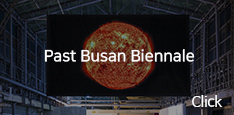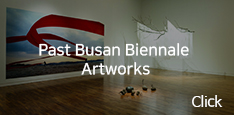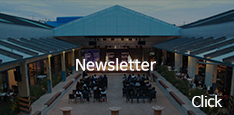Theme
|
Hybridizing Earth, Discussing Multitude The Biennale is a discussing multitude where artists and scholars of diverse religions, ethnicities and nationalities gather to discuss the issues of humanity’s past, present and future. Unlike literature, film and other cultural domains, this is a unique stage that can only be offered through the art genre and the biennale platform.The Busan Biennale 2016 is expecting 121 artists from 23 countries through the Project 1 and Project 2. It will be a place where art as well as architecture, design, performances and seminars come together, a scene where different views and heterogeneous languages clash and coexist. This year, the addition of F1963 (KISWIRE Suyeong Factory, approximately 9,900㎡) to the Busan Museum of Art (approximately 6,600㎡) will create the greatest scale throughout its history of Busan Biennale. The Busan Biennale 2016 will be contisted of two exhibitions (Project 1, Project 2) and a seminar (Project 3). It will address the relationship of continuity-discontinuity-interconnection between the avant-garde system before the 90’s and the global Biennale system that spurred since the 90’s. This is the underlying question of the ‘Biennale’ as a form of exhibition and it will provide introspection and criticism on the existence of artists. |
|
Busan Biennale 2016 Project 1 an/other Project 1, entitled ‘an/other avant-garde china-japan-korea,’ will be held at the Busan Museum of Art.
Co-curated by five curators from China, Japan and Korea, this exhibition will feature autochthonous
experimental avant-garde art of China, Japan and Korea from the 1960s through the 1980s. Here, the
singular ‘an’ denotes the homogeneous avant-garde spirit of China-Japan-Korea. And while the three
countries shared the same avant-garde spirit, ‘other’ stresses the differences in social and political
environment each had faced, giving rise to different respective forms of expression. Lastly, the three
countries representing Asia in this exhibition are shown in the alphabetical order ‘china-japan-korea.’
The Project 1 will exhibit 148 artworks from 65 artists (teams), accompanied by joint archives and
supporting materials on China-Japan-Korea to provide context and background of China-Japan-Korea
avant-garde art within the world art history. China <Avant-garde art in China 1976-1995> In 1976, the Great Proletariat Cultural Revolution came to an end in China. At the cusp of such historically and politically significant moment, the redefinition and new departure for Chinese contemporary art was underway.
GUO Xiaoyan Japan <Avant-garde Art in Japan After War> The avant-garde in Japan was introduced by foreign travelers into Japan shortly after World War I slightly later than in Europe. Then in 1930s avant-garde movement reached its peak in 1930s with Dadaism and Surrealism at the center. However, this movement changed its affiliated function as the military in Japan gained force and artistic circles cooperated with the national policy. Then the movement faded rapidly, disappearing in early 1940s. In this meaning, the avant-garde in Japan was being decimated once again. But the avant-garde in the art of Japan could be revived by Okamoto Taro, challenging the artistic circles in Japan which attempted to return to the precedent form without the liquidation of the past after War. SAWARAGI Noi Korea <Korea's Avant-Garde Movement: A Rebellious Escape> The Korean section of an/other avant-garde china-japan-korea in the Busan Biennale 2016 sheds light on the works of artists who, from the late 1960s to the late 1980s, raised questions concerning the established systems and pursued avant-garde experimental works to overcome them. During this period, grand discourses mostly featured Dansaekhwa (Korean monochrome painting) and Minjung misul (People’s art) or formalism modernism and social realism. This section focuses primarily on a group of artists who explored new idioms in a realm between these two grand subjects and their activities. This section is intended to display the works of artists who have seriously considered the correlation between the two art movements on the border between form and content. It also tries to re-evaluate the diverse potentials of contemporary Korean art through reinterpretations of such art forms’ relatively non-uniform experimental traits. In doing so it aims to elucidate the origin of multifarious contemporary Korean art after the 2000s by examining the characteristics and attributes of Korean avant- garde art amid the streams of avant-garde art connected to the small-group activities of the 1980s such as the Korean Young Artists Association Exhibition, the Fourth Group, AG Group, the Daegu Contemporary Art Festival, Hyuck Group, ST Group, and Meta-Vox Group. KIM Chan-Dong |
|
Busan Biennale 2016 Project 2 Hybridizing Earth, The digital technology that transcends time and space and makes networking possible has tied the earth into a single community, integrating the world into a single market. Within an app installed on our smartphones, 10 billion people around the world transcend their religious, ethnical and national boundaries and are networked together. Humanity is currently living in a ‘generation of multitude’ that no other generation has ever experienced. YUN Cheagab |






















